∙ FAQ ∙ Press Release ∙ Structure Analysis Report ∙ 4/21 Press Release ∙ Detailed C Structure Analysis ∙ 6/16 Press Release ∙
Airport Hangars Historical Timeline
How did we get here?
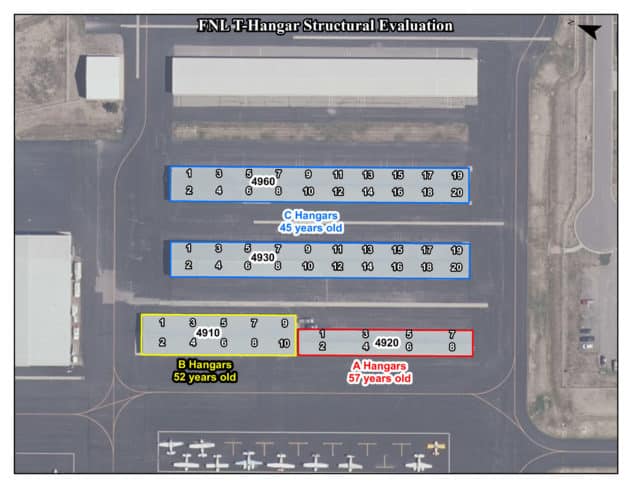
T-Hangar Historical Timeline
Overview
The Cities own four hangar buildings that were originally built between 1965 – 1977, ranging from 45 – 58 years in age. The four buildings contain 57 usable hangar units with 64,500 square feet of storage space and are currently managed and maintained by the Airport/Cities. These units are rented on a month-to-month basis to owners of small aircraft.
A-Hangars, 4920 Grumman Street
In 1964 the Airport was opened, and during that time the A-hangars were constructed. This building currently consists of a total of 8 units and relatively low build quality, similar to a metal barn with sliding doors. It was moved from its original location and since moving was modified by removing an end to make room for a taxiway. Records relating to how it was built, original ownership, and how it was acquired by the Cities are not available. Notice that the picture below from approximately 1966 shows the A-hangar building where the General Aviation Terminal FBO South hangar exists today, as compared to the photo above that shows it turned 90 degrees and on the opposite end of the general aviation ramp.

B-Hangars, 4910 Grumman Street
This hangar building was constructed in approximately 1974. It consists of ten (10) units and was identified by the report as the greatest safety concern due to the sliding doors and structural issues that exist. This hangar was the second building constructed on the airport for aircraft storage. The history of these hangars as it pertains to when they were constructed or when the Cities became owners of them is not available in Airport or City files. It is assumed to have been privately built on a 30-year ground lease that expired in the early 2000’s, at which time ownership of the building reverted to the Cities.
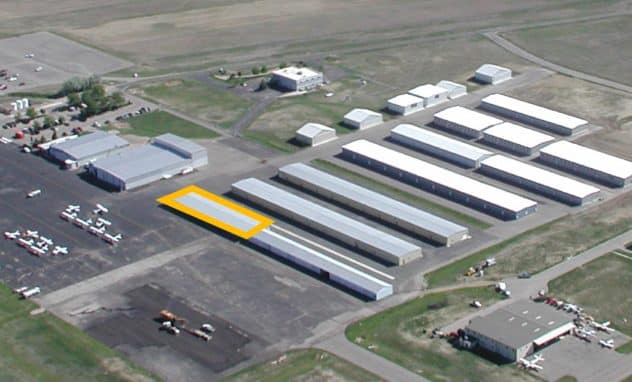
C-Hangars, 4930 & 4960 Grumman Street
These units consist of two buildings that contain twenty (20) individual units each, for a total of forty (40) units. These hangars were constructed in 1977 and were known as the Falcon T-Hangar Association. These buildings originally had a 30-year land lease that was renegotiated from 2007 to 2010 and granted another ten-year lease extension by the Cities. Over time these hangar units were acquired by the Cities when hangar owners sold them under the Cities’ right of first refusal, and by 2007 the Cities had acquired 21 of the 40 total units. The blue hangars in the image below reflect the units that were owned by the Cities prior to 2020.
The hangars owned by the Cities were scattered throughout the two buildings. It is assumed that the strategy for acquiring these hangars during the 1990’s and early 2000’s was done for the sake of control and revenue production. The remaining units reverted to Cities’ ownership after the final lease extension expired in 2020 for a total of forty-three (43) years.

Airport Planning
The Airport Master Plan is the guiding document that is used for the development and redevelopment of the airport. This document is updated every 10-15 years and includes input from airport stakeholders and the general public. The Master Plan was updated in 2007 and 2020, both taking approximately two years each to create and incorporate public input prior to adoption by the City Councils. The Airport Master Plan for each specify that the area is to be redeveloped with larger hangars to leverage the other infrastructure that exists in the area and support the diverse mix of aircraft that use the Airport today. See the excerpts from the Master Plans below:
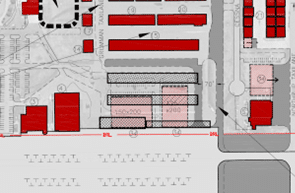
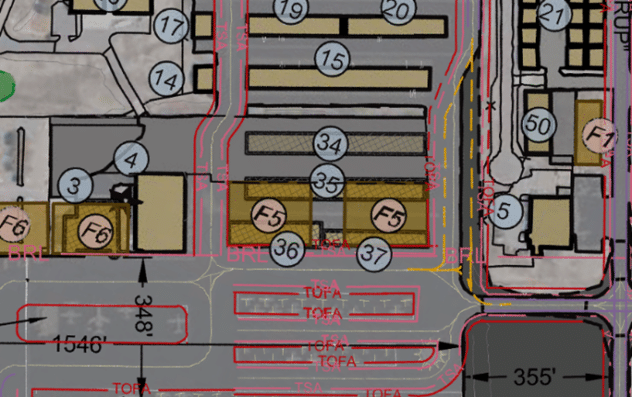
Redevelopment Proposals
In 2021, an unsolicited proposal was received from the Airport’s fixed base operator (FBO), jetCenters of Colorado, to redevelop the hangar area. This proposal was provided knowing that the area was targeted for redevelopment, and that the Cities now own all of the hangar units. Upon review by the Airport Commission, it was determined that the area needed to go through a formal advertised request for proposals (RFP) process from interested parties. The RFP was advertised in late 2021 and generated three responses. An evaluation committee reviewed the proposals, collected additional information, engaged in negotiations, and made recommendations to the Airport Commission. Ultimately, the Airport Commission voted to close the RFP without award.
New Hangar Construction
In 2019, a new ground lease was approved by the Airport Commission for AeroFNL to construct a 77,000 square foot, five building hangar project. This project was delayed with the pandemic and was able to move forward late last year. The 23-unit complex is expected to be complete by the end of 2023 or early 2024 and will have the capacity to accommodate many general aviation aircraft.
The price point of these hangars is not known, but is expected to be higher than the retired hangars. Some costs can be reduced if aircraft owners partner to help share the cost by storing multiple aircraft in each unit. The total square footage of these buildings exceeds that of the t-hangar buildings being decommissioned by approximately 12,000 square feet, representing an overall increase in general aviation storage capacity at the Airport.
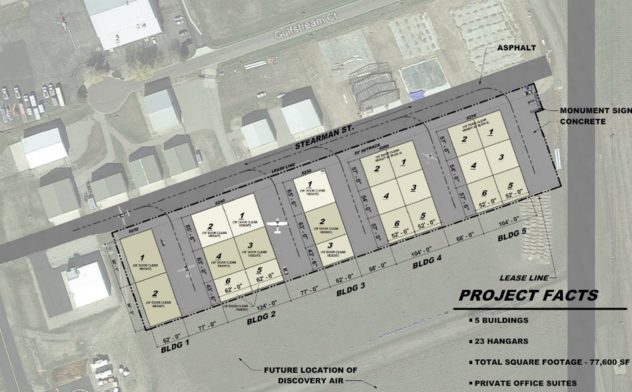
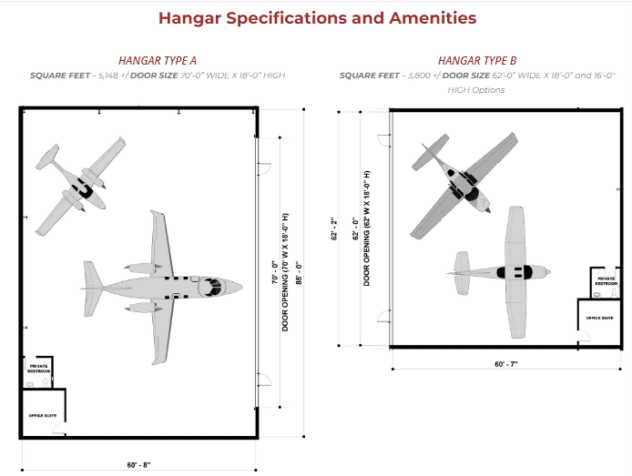

FAQ
Background
Q. How old are the hangars?
A. The four hangar buildings containing 58 units were built between 1965 – 1977 and range in age from 45 – 58 years.
Q. What is the typical lifespan of these buildings?
A. The Airport’s Standard land lease agreements were 30-years when these hangars were constructed, and the building quality is reflective of that as the anticipated lifespan. Various factors such as foundation preparation, building materials, environmental conditions, maintenance, and usage all impact the actual lifespan.
Q. Were structural analyses of the hangars completed prior to 2022?
A. No, although the units have been regularly inspected by Airport staff, the recent structural evaluation was the first time licensed structural engineers had inspected them.
Q. Has regular maintenance been performed on the hangars?
A. Yes, Airport staff have performed ongoing maintenance on all City-owned units and have completed numerous repairs to enhance the safety and functionality of the buildings. The units have reached a point where the Cities are unable to continue to manage the risk for their continued use and all available options to extend the lifespans of these buildings have been exhausted.
Q. How long has this redevelopment of the T hangars been planned?
A. The Airport Master Plan has identified this area for redevelopment since 2007. This was reiterated in the 2020 Master Plan, which also included a significant amount of public outreach and was adopted by both City Councils. The exact timing of the retirement of the buildings and redevelopment of the area were not addressed by the plans and were expected to be influenced by the condition of the buildings and market demand for larger hangars.
Q. Were these plans communicated to tenants?
A. The Master Plan update was a two-year planning process that included a significant amount of public outreach including over thirty public meetings and open houses to engage stakeholders to provide input. Following the unsolicited redevelopment proposal in 2021, Airport staff and the Commission shared extensive information and received a great deal of feedback from the tenants. Public meetings were held during the drafting of the request for proposals (RFP) that was issued following the unsolicited proposal and updates related to the RFP have been provided at public meetings and by email.
Rationale for Decision
Q. Why are the hangars leases being terminated?
A. The retirement of the hangar buildings has been expedited due to structural defects and safety concerns identified through the recent structural analysis. The structures have met or exceeded their service lives and can no longer be effectively maintained or repaired to allow for ongoing use.
Q. Do the Cities/Airport support General Aviation (GA)?
A. We understand this decision will have a negative impact on many of the Airport’s users. While we knew this time would eventually come, the Airport was able to maximize the time that the units were able to be safely leased. With the newly obtained information on the condition of the hangars, the Airport has an obligation to mitigate a potentially unsafe situation.
Q. Why was this considered during executive session without tenant input?
A. The executive session was permitted under Colorado Revised Statutes for the purposes of attorney client privilege to discuss and consider the status of hangar leases and lease negotiation options and providing direction to staff regarding the leases of the hangars owned by the Cities. No action was taken during executive session.
Q. How/when can tenant input be share with decision makers?
A. The Airport Commission held a special Commission meeting on March 2nd to make the official decision public. Additionally, a town hall will be held on March 9th at 3:30 pm at jetCenter, located at 4824 Earhart Road, Loveland, CO 80538, to allow tenants a second public forum to share their input. Emailed input will also be shared with the Commissioners.
Q. Was a more detailed analysis or second opinion sought?
A. Airport staff requested an additional investigation to complete a more comprehensive structural condition sampling within the T-Hangars from the engineering consultant. The engineers stated:
“with the structural conditions witnessed during the initial field inspection, it is highly anticipated that similar conditions exist throughout the remaining structure. It is our professional opinion that regardless of condition in the remaining T-Hangars, the condition witnessed in the inspected units is not salvageable and the structures are not candidates for retrofit. Based upon the observed condition of the T-Hangars, it is our professional opinion that the T-Hangars have met or exceeded their useful design life and additional analysis of the T-Hangars will yield the same result.”
At the March 16 Commission meeting, Airport staff were directed to work with Cities staff and tenants to complete a second analysis to bring to the Commission at their April 20 meeting to consider.
Q. Can repairs or modifications be made to extend the lifespans of the buildings?
A. No, the structural analysis concluded that:
“all four of the structures were observed to have significant issues with the subgrade, foundation, anchorage, and structural members. The structural framing members are not salvageable due to the on-going damage from wind, snow loading, soil heave, and poor foundational connection and support. The members have been compromised and are torqued, deflected, buckled, and are no longer square. Due to the cumulative effect of the issues observed, there is not an opportunity to implement an isolated repair without addressing the structure in its entirety.”
The engineers concluded that all the buildings have:
“met or exceeded their service life and are not candidates to retrofit to meet current codes. There are no recommendations for remediation to safely extend the lifespan of the hangars.”
Q. Could the risk/liability be assumed by the tenants?
A. Staff investigated the ability to extend the use of these hangars through waivers or new land lease agreements. Due to the condition of the buildings, these options were determined to not be viable as they didn’t address the safety concerns.
Q. Could a construction company rebuild the existing buildings?
A. Reconstructing the buildings would not align with the Master plan and would likely cost more than constructing new buildings in a different location. Isolated repairs cannot address the multiple points of failure identified in the structures, such as failing foundations. Additionally, it is not financially feasible to bring these buildings up to current building code standards with the level of modification needed.
Impacts & Next Steps
Q. Is there a financial impact to the Airport?
A. Yes, the Airport generates approximately $175,000 in annual revenue from hangar rental fees associated with the four buildings. This revenue was known to be time limited, and redevelopment of this area will create new long-term revenue streams. Safety is the primary driver of this decision, not financial considerations.
Q. What will happen to this area of the Airport?
A. Due to the poor condition of the buildings and associated safety risks, these units will be dismantled and removed from the Airport. Eventually, a request for proposals (RFP) will be issued for new development in this area in the future.
Q. Why doesn’t the Airport build more hangars?
A. The Cities have not historically constructed aircraft hangars. In the past, the Cities have applied available funding to common-use horizontal infrastructure such as utility networks, roadways, and taxiways in order to encourage private development of hangars. The Airport has seen considerable growth in recent years, leading to a lack of shovel-ready property. To prepare for the future, the Airport recently started a planning effort focused on preparing new sites for hangar development.
Q. Will this happen to other hangars on the Airport?
A. New leases can be negotiated at the discretion of the Cities, provided the buildings are still structurally sound and in alignment with the Master Plan. This was recently done with a T-hangar building that is adjacent to the Cities owned hangars.
Q. Why are the Cities applying CARES funds to the Terminal project instead of GA projects?
A. The Cities chose to apply the CARES Act funding to the terminal project in 2020 as it will provide the most impact for the largest number of residents in our region. Throughout the Airport’s history, the development of aircraft hangars has been accomplished by the private sector. Shifting the funding to the T-hangars would provide limited benefit to a handful of citizens, whereas the new terminal is intended to provide use of the Airport to a much wider spectrum of the public. Also, pivoting at this time would not be feasible as the planning needed for a new project would not be completed in time to meet the federal funding usage deadline of July 2024.
Q. What is the expected process for vacating the hangars?
A. The Airport Commission directed staff to terminate the leases at the special meeting held on March 2nd after exhausting every option available to the Cities to keep the hangars open. Airport staff will send postal notices and emails directly to the affected users of the hangars. Staff will also follow up with listening sessions conveying the information.
Q. How long do tenants have to vacate?
A. The Cities have directed staff to terminate all lease agreements. At the February 16 the Commission directed the higher risk buildings 4910 & 4920 Grumman to be vacated no later than May 10. The 4930 & 4960 Grumman buildings were to be vacated no later than July 10.
- At the March 16 meeting the Commission extended the dates by 30 days, which was June 10 for A and B hangars and August 10 for C hangars.
- At the April 20 meeting the Commission extended the date for the C hangars to no later than October 10.
Q. Are extensions available?
A. At the February 16 Commission meeting, staff were told no extensions would be allowed.
- However, after determining the amount of time given would not allow tenants enough time to develop a proposal the Commission provided a 30 day extension for all tenants at their March 16 meeting. That pushed the deadline to June 10, 2023 for A and B hangar tenants and August 10 for C hangar tenants.
- At the April 20 meeting the Commission moved to further delay the evacuation deadline for C hangar tenants to October 10 after a safety focused structure analysis report was presented. They also required that the full structural report with cost estimates for repair options and required code updates would be provided no later than their July 20 meeting and that existing A and B hangar tenants in compliance of their lease agreements would be given priority placement in any vacant C hangars. The Commission then ordered staff to complete a safety focused structure report for the A and B hangar buildings and clarified that this direction would not extend the deadline for A and B hangar buildings.
Q. Why can’t this be phased over a longer timespan?
A. The Cities have an obligation to prioritize the safety of its public and employees, and with the new information have an obligation to protect the safety of all.
Q. I paid multiple months in advance/How do I receive my refund?
A. After the hangar is vacated and the keys are returned, a final hangar inspection will occur. Once the hangar is found to be returned in the condition it was received to the tenant (not full of hazardous waste, etc…) then the unused months and/or last month’s free lease and security deposit if applicable will be refunded to the tenant by check. Please ensure your mailing address is up to date.
Q. Where can displaced tenants keep their airplane?
A. The aircraft tie-down area on the main ramp is available on a first come first serve basis. The Airport plans to provide additional temporary space if needed. A new hangar development is being built and is expected to be complete by end of this year.
The following lists are entities that may assist with aircraft storage needs:
On Airport:
- Aero FNL 720-574-2018
- Discovery Air 970-460-8606
- jetCenters of Colorado 970-667-2574
- Latched Kowell, LLC 512-507-9261
Other Airports in the Area:
- Sterling Airport 970-520-1283 – space available now
- Greeley-Weld County Airport 970-336-3000
- Longmont Airport 303-651-8431
- Rocky Mountain Metropolitan Airport 303-271-4850
- Boulder Municipal Airport 303-441-3108
- Cheyenne Regional Airport 307-634-7079
Q. Are the Cities/Airport doing anything to help?
A. To help this transition, the Airport will provide on-site collection for waste and hazardous materials during the transition period for all affected tenants. Additionally, the Airport Commission has committed to provide six (6) months of funding for ramp tie-downs for affected tenants’ aircrafts and are waiving the last month of hangar rent.
Q. Why are hangars so hard to find and more expensive?
A. The Cities have not constructed facilities on the Airport for private aircraft storage, nor are there resources to do so. The only hangars that the Cities own and operate are those that have reverted to Cities ownership after the expiration of long-term lease agreements.
Q. What are the Cities/Airport doing to support construction of more general aviation hangars?
A. The Airport Commission is developing an infrastructure plan for the area north of runway 6/24. The Airport is seeking to partner with private developers to build more hangars for the general aviation community.